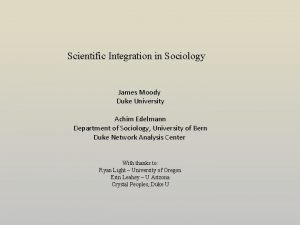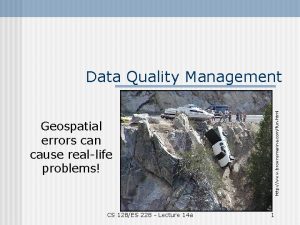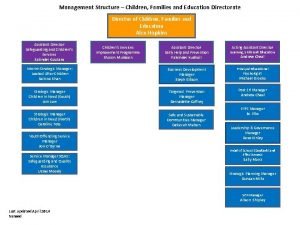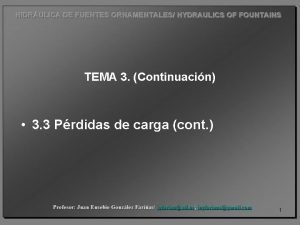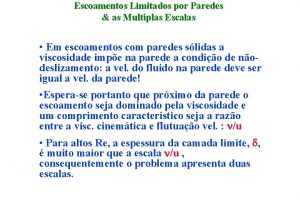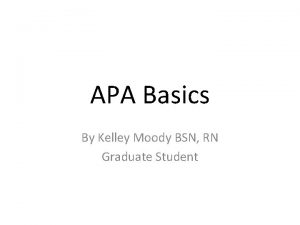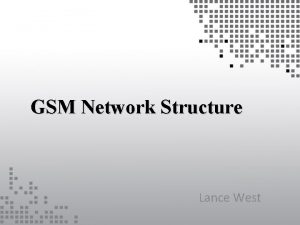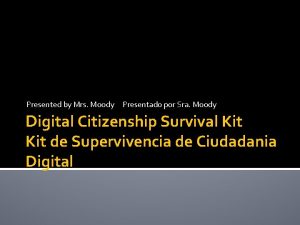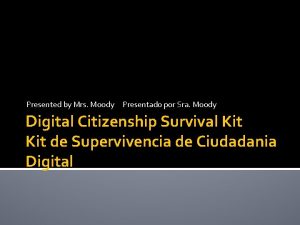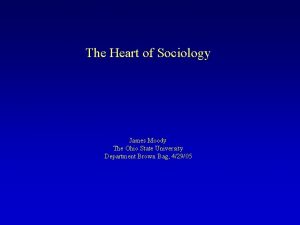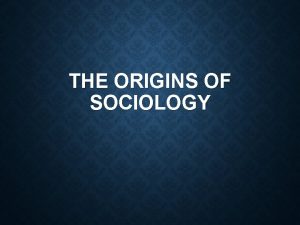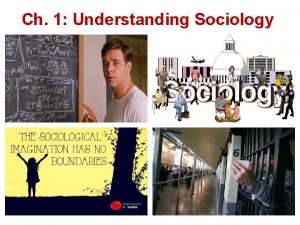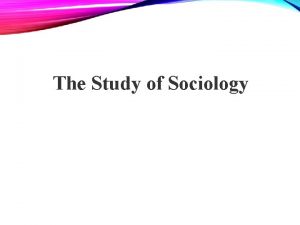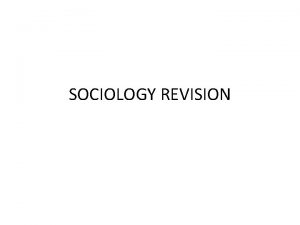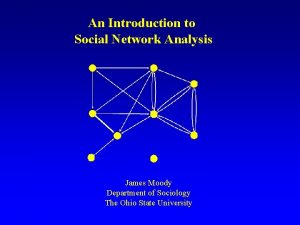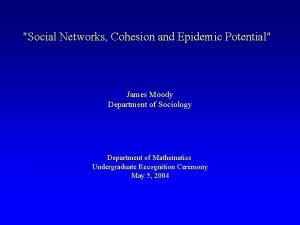The Network Structure of Sociology Production James Moody





































































- Slides: 69

The Network Structure of Sociology Production James Moody Duke University Stanford University Colloquium March, 2007

Introduction Outline: • Networks & Science: Two Questions & 4 networks • How do scientific fields evolve? • Where do good ideas come from? • Data Sources & Methods • Results • Where does sociology fit? Journal co-citation networks • What do sociologists study? Topic networks • Who produces sociology? Social science collaboration networks • Discussion

Networks & Science: Two Questions & 4 networks "Science, carved up into a host of detailed studies that have no link with one another, no longer forms a solid whole. " Durkheim, 1933 Stratification Social Welfare Organizations Historical Sociology Crime Gender Health

Networks & Science: Two Questions & 4 networks 1) How do scientific fields evolve? a) Is there a coherent logic to the ebb and flow of topics studied? b) How does the success or failure of ideas depend on the social community in which it is embedded? c) (How) Does the evidentiary basis of a field shape it’s logic of discovery? The descriptive answer is given by mapping the field in network space. The analytic answer will come by modeling the emergence, growth and decline of scientific subfields.

Networks & Science: Two Questions & 4 networks 2) Where do good ideas come from? a) What is a good idea? a) Ideas that change a scientific field. Indexed by (a) citations and (b) the relevant topography of the networks within which the idea was originally embedded. Ideas are not inherently good; they are recognized as “good” by their effect on a field. b) How do disciplines produce new ideas? a) Intersection Good ideas are produced by combining ideas of others in unique ways (Burt) b) Development Good ideas arise naturally from either the progressive “error reduction” process of good normal science (Popper) or the accepted practices of a scientific community (Crane). c) Peer Influence & Recognition Any idea is a good idea if others think so, and thinking so is influenced by the network. (Gould). d) Resource competition Search for prestige conditioned by organizational structure (Fuchs) Will model this by examining how citations are affected by field dynamics (and vice versa).

Networks & Science: Two Questions & 4 networks Theoretical approaches to scientific development We are thus left with multiple action frames to guide our understanding: Truth: Ideas run their error-reduction course (Popper) Prestige: Actors seek the greatest visibility (Merton) Resource competition: “To the victor goes the spoils” – Fuchs Boundary Protection (Gieryn ) Fractal Development (Abbott) Community Influence (SSK – Collins, etc) Peer magnification (Gould) Power (JL Martin) For entire fields, these mechanisms are largely unknown and underspecified. Need to extend beyond particular lab studies Take a large-scale “Satellite” view of science dynamics Link action frames to specific patterns in 4 science networks

Networks & Science: Two Questions & 4 networks Theoretical approaches to scientific development Four relevant networks: 1. Citation networks – a direct trace of scientific recognition & production 2. Topic networks – clusters of scientific products related to the same subject 3. Collaboration networks – “invisible communities” of social interaction that produces scientific products 4. Research Communities – People linked through common research topics (Substantively a derivative of 2 & 3)

Networks & Science: Two Questions & 4 networks Scientific Environments Evidentiary Basis: How do we array disciplines with respect to evidence? Two Dimensions: Objectivity & Control Objectivity is taken from Popper: The extent to which a given knowledge claim is independent of the knower. Control refers to the ability of scientists to directly manipulate the object of study. “Lab Science” with complete ability to control apparatus (and thus environment) represents the strongest ability, while “observation” represents the other. Cases: Chemistry (Lab Science: High Objectivity & High Control) Paleontolgoy (Field Science: High Objectivity & Low Control) Sociology (Social Science: Moderate Objectivity & Low Control) Cultural Anthropology (Low Objectivity & Low Control) This approach is very similar to Fuchs (1993)

Networks & Science: Two Questions & 4 networks Chemistry Paleon Sociology Citation Journal Citation Structure Topics Subfield Evolution Collaboration Community Collaboration & Cohesion Cultural Anthro

Networks & Science: Two Questions & 4 networks Focusing on Sociology as a current case The field of sociology can thus be thought of as the intersection of multiple networks. The shape of these networks differs across scales and over time. - Differences between local and global visions of the network shape our perceptions of scientific coherence. - We tend to perceive coherence in our own specialty fields and incoherence for the entire discipline. - A globally federated structure, that cannot easily exclude empirical topics, might still be socially coherent if scientific mixing crosscuts empirical problems. We can see this structure by examining these 4 networks at large scale and over time.

Data Sources • Citation Networks • Compiled from the ISI web of science Journal citation tables • Covers 1681 social science journals indexed in 2003 • Will eventually -fill this series from 1950 to present across all fields. -Add a sample of paper-level citations to model performance. • Topic & Collaboration Networks (for Sociology) • Compiled from Sociological Abstracts • 281, 163 papers published between 1963 and 1999 • A sub-sample of “sociology only” papers published in a select set of non-specialty sociology journals 35% of the total (~100 K) • Contains information on title, abstract, keywords, author(s), tables, journal & citation • Will use similar indexes for Chemistry, Geology and Lit Crit

Where does sociology fit? • Perennial debates over the existence of a theoretical core • Rapid growth in the internal diversity of topics sociologist study: 50 45 Number of ASA Sections 40 35 30 25 20 15 10 5 0 1950 1960 1970 1980 1990 2000 2010

Where does sociology fit? • Perennial debates over the existence of a theoretical core • Rapid growth in the number of journals relevant to sociologists:

Where does sociology fit? This growth & diversity has been seen as evidence for the ultimate emptiness of sociology as a scientific discipline. But disciplines are shaped by the connections between ideas, not the number of ideas. That is, we recognize fields by who they speak to as much as by what they speak about. The clearest empirical trace of this communication is citation. Disciplines can then be defined as clusters of work that speak more to each other than to anyone else, which we trace with co-citation networks.

Where does sociology fit? Building co-citation networks Links in a co-citation network are constructed by measuring how similar each journal is to every other journal. Similarity is gauged by correlating the pattern of citations received by each journals from every other journal. AJS ASR AER … JER J 1 # # 0 0 J 2 # # 0 0 J 3 0 0 # # J 4. . . JER 0 # # # 0 0 # # Comparing across columns tells us whether the two journals are recognized by others as similar.

Where does sociology fit? Building co-citation networks Links in a co-citation network are constructed by measuring how similar each journal is to every other journal. Similarity is gauged by correlating the pattern of citations received by each journals from every other journal. AJS ASR AER … JER AJS 1. 0 ASR High 1. 0 AER. . . JER Low Med 1. 0 Low High 1. 0 This create a valued network of ties between two journals. I use a cosine similarity score developed in bibliometrics, selected for those with ties > 0. 45 & at sharing at least 2% of their citation volume. Source: Loet Leydesdorff

Where does sociology fit? Economics co-citation similarity network Density = 0. 197 N=152 Isolates (not shown): 5 Node size proportional to log(degree)

Where does sociology fit? Political Science co-citation similarity network Density = 0. 160 N=69 Isolates (not shown): 10 Node size proportional to log(degree)

Where does sociology fit? Sociology co-citation similarity network Density = 0. 140 N=69 Isolates : 7

Where does sociology fit?

Where does sociology fit?

Where does sociology fit?

Where does sociology fit? • Sociology “fits” at the center of the social sciences. We are not as internally cohesive as Economics or Law, but more so than many (anthropology, allied health fields). • This represents a tradeoff. We have traded unique dominance of a topic (markets, politics, mind, space) for diversity & thus centrality. • Sociology is an interstitial discipline (Abbott, 2004) in at least two-senses: • There is no content topic we can reasonably exclude • We pull together, and generate, the ideas and topics covered by specialty disciplines. • This makes us uniquely positioned to provide insights on many different empirical questions. How have the topics sociologists study shifted over time?

How does this look in the Physical Sciences?

What do sociologists study? How do we capture the internal organization of research problems? • Could use paper-level citation networks (see Hargens 2000), but data are difficult & expensive to obtain for large-scale networks. • Can examine the network of papers formed by the topics they write about. • Directly taps scientific content • Purely endogenous creation of topics that allows new topic areas to emerge and old ones to die over time • Tractability: data can be extracted from information held in Sociological Abstracts • Multiple levels: • Coarse grained Focus solely on keywords (Light 2005) • Fine grained Use all information available (title, abstract, keywords)

What do sociologists study? A fine grained view Data Selection & Manipulation: Index entries contain title, abstract and keywords that summarize the paper’s content. • Sample all papers indexed within four 3 -year windows between 1970 and 1999. • Construct a paper – by – word matrix, where the ij cell lists how many times word i is used to describe paper j. • Word set is stemmed to get at root words • A stop-list is used to minimize inclusion of low-information content words (“the” “and” “is” etc. ) or words commonly found in the data source (“Tables” “Figure” “References”) • Construct a network by linking the most highly correlated papers • Use correlation of 0. 40 or better • Ties are treated as valued in the network analyses

What do sociologists study? A fine grained view Analysis & Presentation: General approach is “quantitatively inductive” - Construct a low-dimensional map of the network, using contour sociograms. These allow for full information in the network structure. -Use cluster analysis to identify distinct topics -Use a variant of Moody’s RNM algorithm to cluster the network This clustering routine: (a) is efficient: Allows clustering on 10 s of thousands of nodes (b) automatically specifies the optimal number of clusters (c) allows that some cases can fall ‘between’ clusters -I set a minimum cluster size of 12 papers published over the 3 -year window. -Evaluate the clustered papers for content and label the maps.

What do sociologists study? A fine grained view Analysis & Presentation: General approach is “quantitatively inductive” Compare the maps over time qualitatively, looking for general changes in the frequency & alliance of topics. Examine shifts in structural indicators of the extent of clustering & cluster size distributions.

What do sociologists study? A fine grained view Example: One-step neighborhood of “More information, better jobs? ”

What do sociologists study? A fine grained view Example: One-step neighborhood of “More information, better jobs? ”

What do sociologists study? A fine grained view: Content (all journals)

What do sociologists study? A fine grained view: Content (all journals)

What do sociologists study? A fine grained view: Content (all journals)

What do sociologists study? A fine grained view: Content (all journals)

What do sociologists study? A fine grained view: Content (all journals) The cluster content of the topic network has evolved slowly: • Some clearly central specialties have remained prominent over the entire period. This includes larger areas such as: • Class & Stratification • Race & Ethnicity • Education • Gender (Strongest from 1980 s on) • Family (Strongest from the 1980 s on) • Crime As well as clearly distinct, though numerically smaller bodies of research related to • Suicide • Sociology of Science, Technology & “Reflexive” sociology • Unions

What do sociologists study? A fine grained view: Content (all journals) The cluster content of the topic network has evolved slowly: • The clearest change has been the rapid growth of social research on health. • Dominated by a very large body of research related to HIV/AIDS • Other areas of relative growth include: • Family topics were most prominent in the 1980 s • A strong presence of research on sex & sexuality emerged in the 1980 s and 90 s • Relative declines have come in areas such as: • Groups • Interaction • “Radical” studies • Elite studies Summary: A move away from basic social processes toward studying social problems, with a growing uniqueness of theory & method

What do sociologists study? A fine grained view: Content (Restricted Sample)

What do sociologists study? A fine grained view: Content (Restricted Sample)

What do sociologists study? A fine grained view: Content (Restricted Sample)

What do sociologists study? A fine grained view: Content (Restricted Sample)

What do sociologists study? A fine grained view: Content (Restricted Sample) The cluster content of the restricted topic network has evolved similarly to the wider social science field: • The subfield structure is less dominated by the purely applied work on HIV/AIDS in the 90 s, but there is a still a clear association of topics around sexuality, health and AIDS. • Health, Family, Education, Gender, and Race are always prominent and large. • The relative prominence of “reflexive sociology” is much higher – • These topics cannot be published elsewhere, and the resulting tight cluster looks proportionately larger in the smaller sample.

What do sociologists study? A fine grained view: Content We can measure the degree of consensus in words used to describe papers with: C = S pi 2 Where pi is the proportion of times word i is used

What do sociologists study? A fine grained view: Content C (x 100) Word Consensus Scores 1970 - 1999 Soc Only All SA Journals

What do sociologists study? A fine grained view (Core Soc) Proportion of papers falling inside a cluster Total Cn > 12 Restricted Total Cn > 100 Restricted

What do sociologists study? A fine grained view We can measure the extent that ties fall within clusters with the modularity score: Where: s indexes clusters in the network ls is the number of lines in cluster s ds is the sum of the degrees of s L is the total number of lines

What do sociologists study? A fine grained view Network Modularity 1970 - 1999 Modularity Score All SA Journals Soc Only

What do sociologists study? A fine grained view Total Number of Clusters 1970 - 1999 All Journals Soc Only

What do sociologists study? A fine grained view Mean Cluster Size 1970 - 1999 Mean Size of Clusters All Journals Soc Only

What do sociologists study? A fine grained view The cluster structure of the topic network: • The vast majority of papers can be assigned to clear clusters, with slight growth in this proportion over time. • The number of clusters has increased rapidly, though slightly slower within core sociology than in the broader field of social science. • There has been significant growth in the tails of the distribution – the size distribution is more skewed in later periods. • The modularity of the network has increased over time, though most of this change is between the 1970 and 1980 periods. This meshes with our intuition of “separate worlds” in the social sciences: larger, more distinct topical production of science work.

What do sociologists study? A fine grained view Next steps: 1. Build a continuous moving window to fill in the dates from 1960 to 2005. 2. Link clusters across time periods, so we can track exactly the relative growth and decline of each subfield. 3. Model this growth as a function of connections to other fields, author composition and disciplinary environment. 4. Build this network’s dual: scientists connected through topics.

What do sociologists study? A clustered topic structure focused strongly on practical problem solving has a hint of Durkheim’s concern: Is there any integration across these topic clusters? We shouldn’t jump too quickly to the fractured conclusion: • Topic clusters are formed from papers, and papers typically have well encapsulated ideas. They have a small “maximum digestible unit” • Scientific integration is really about how scientists bridge these multiple topics. • If authors write and collaborate across these topics, ideas can quickly disseminate as well. What is the structure of the collaboration graph – if this is highly clustered it would signal potential fragmentation Who produces sociology?

Who produces sociology? Science is typically produced through collaboration, both formally and informally (Crane 1972, Crane & Small 2000, Friedkin 1998). The best empirical trace of collaboration for large communities of science is coauthorship. • Misses the less intense collaborations recognized in acknowledgements, discussions, colleagues reading each other’s work • But should provide the strongest test of a fractionalization hypothesis, since the set of people we write with should be more like us than the set of people we have lunch with or discuss work with informally. • There are differences across subfields in formal collaboration rates, which, if anything, should magnify the extent of observed fragmentation.

Who produces sociology? Coauthorship Trends in Sociology Sociological Abstracts and ASR Proportion of papers with >1 author 0. 75 0. 6 0. 45 0. 3 Sociological Abstracts ASR 0. 15 0 1930 1940 1950 1960 1970 Year 1980 1990 2000

Who produces sociology? Distribution of Coauthorship Across Journals Child Development Sociological Abstracts, 1963 -1999 Proportion of papers w. >1 author 1 0. 8 Soc. Forces J. Health & Soc. Beh. ASR 0. 6 J. Am. Statistical A. 0. 4 AJS Atca Politica Soc. Theory 0. 2 Signs J. Soc. History 0 0 100 200 300 400 500 600 700 Coauthorship Rank 800 900 1000 1100

Who produces sociology? Construct a collaboration network by assigning an edge between any pair of people who coauthored a paper together. Example Paths: 3 -steps from Stan Wasserman N=361

Who produces sociology? Construct a collaboration network by assigning an edge between any pair of people who coauthored a paper together. Example Paths: 3 -steps from Stan Wasserman N=361 Node size proportional to log of degree

Who produces sociology? The simplest summary test for a fragmented network is to measure the extent of clustering in the network. Watts’ work on the “small-world problem” suggests that if the collaboration network is a small world network it might be fractured. C=Large, L is Small = SW Graphs • High relative probability that a node’s contacts are connected to each other. • Small relative average distance between nodes

Who produces sociology? In a highly clustered, ordered network, a single random connection will create a shortcut that lowers L dramatically Watts demonstrates that Small world properties can occur in graphs with a surprisingly small number of shortcuts

Who produces sociology? Locally clustered graphs are a good model for coauthorship when there are many authors on a paper. Paper 1 Paper 2 Paper 3 Paper 4 Paper 5 Newman (2001) finds that coauthorship among natural scientists fits a small world model. I test this model on the sociology coauthorship network, using all authors from 1963 – 1999.

Who produces sociology? Clustering Distance Observed Random 0. 194 0. 206 9. 81 7. 57 The sociology network is less clustered than would be expected by chance and somewhat longer overall distances. This suggests that it does not have a small-world structure.

Who produces sociology? The network has a broad Core-periphery structure (68, 923) 59, 866 38, 823 29, 462 Bicomponent Component Unconnected Structurally Isolated

Who produces sociology? Internal Structure of the Coauthorship Core Health General Sociology

Who produces sociology? • Strong specialty effects for ever-coauthored Unlikely: History & Theory Sociology of Knowledge Radical / Marxist Sociology Feminist / Gender Studies Likely: Social psychology Family Health & Medicine Social Problems Social Welfare

Who produces sociology? • Weak specialty effects for network embeddedness • Large number of coauthors increases embeddedness • Large number of people on any given paper decreases embeddedness

Summary & discussion Social Science Citation Structure • Economics, Law, Psychology, Business/Management, Linguistics are most cohesive • The are also “peripheral” in that they speak to a relatively limited set of problems • Sociology is at least as cohesive as Political Science, and more cohesive than fields such as Anthropology, Social Work, Education or allied health fields that all have more limited empirical domains • Our position represents a tradeoff between internal cohesion and external centrality.

Summary & discussion Scientific Topic Network • Big-Picture: A general progression towards problem solving and the specialization of work on theory & methods (Light 2005). • Fine-grained structure: • A federated topic structure that has largely retained that form since the 1970 s, though there have been shifts in substantive topics. • Key content areas have remained largely constant • Race, Family, Class, Gender, Science, and Health • A decrease in focus on general foundation problems • Group structure, community, interaction • An increase in work on social problems • Health & HIV/AIDS -related topics • Some (minor) evidence for greater homogeneity in topics discussed

Summary & discussion Scientific Collaboration Network • The networks is not divided into small research-area based clusters. • There is no partition that strongly separates scientists. • This has to imply that authors bridge topic clusters. • This is good for social cohesion, and probably good for theoretical cohesion. • Caveat: There is evidence for a division based on research method, with largely quantitative work more likely to be coauthored, though there is no such simple division in the topics network.

Summary & discussion Combined, these models suggest a discipline that is integrated socially and locally cohesive topically. Discipline-wide integration will likely only increase as pressures for collaboration push more scientists to work together across topics. However, the perception of disintegration will likely continue: • because most of us are only exposed outside our areas by work that appears in the general journals. • But almost all of the topical cohesion is due to “normal science” work occurring in specialty journals.

 James moody duke
James moody duke Pre post production
Pre post production Types of sentences
Types of sentences How to read moody diagram
How to read moody diagram Mad eye moody constant vigilance gif
Mad eye moody constant vigilance gif Abigail marsden
Abigail marsden Why is jem moody at the beginning of chapter 7
Why is jem moody at the beginning of chapter 7 Moody tiger
Moody tiger George moody physionet
George moody physionet Hbomba
Hbomba Davina moody drama queen
Davina moody drama queen Learning to trade via direct reinforcement
Learning to trade via direct reinforcement Diagramme de moody
Diagramme de moody Placa plana
Placa plana Coefficient de hazen williams
Coefficient de hazen williams Difficult customer scenario
Difficult customer scenario Apa itu bsn
Apa itu bsn Criminal profiling serial killers
Criminal profiling serial killers Clay lawson and russell odom
Clay lawson and russell odom Sociology exam structure
Sociology exam structure Sociology definition
Sociology definition Hát kết hợp bộ gõ cơ thể
Hát kết hợp bộ gõ cơ thể Bổ thể
Bổ thể Tỉ lệ cơ thể trẻ em
Tỉ lệ cơ thể trẻ em Chó sói
Chó sói Glasgow thang điểm
Glasgow thang điểm Hát lên người ơi alleluia
Hát lên người ơi alleluia Các môn thể thao bắt đầu bằng tiếng chạy
Các môn thể thao bắt đầu bằng tiếng chạy Thế nào là hệ số cao nhất
Thế nào là hệ số cao nhất Các châu lục và đại dương trên thế giới
Các châu lục và đại dương trên thế giới Cong thức tính động năng
Cong thức tính động năng Trời xanh đây là của chúng ta thể thơ
Trời xanh đây là của chúng ta thể thơ Mật thư tọa độ 5x5
Mật thư tọa độ 5x5 Làm thế nào để 102-1=99
Làm thế nào để 102-1=99 Phản ứng thế ankan
Phản ứng thế ankan Các châu lục và đại dương trên thế giới
Các châu lục và đại dương trên thế giới Thơ thất ngôn tứ tuyệt đường luật
Thơ thất ngôn tứ tuyệt đường luật Quá trình desamine hóa có thể tạo ra
Quá trình desamine hóa có thể tạo ra Một số thể thơ truyền thống
Một số thể thơ truyền thống Cái miệng xinh xinh thế chỉ nói điều hay thôi
Cái miệng xinh xinh thế chỉ nói điều hay thôi Vẽ hình chiếu vuông góc của vật thể sau
Vẽ hình chiếu vuông góc của vật thể sau Thế nào là sự mỏi cơ
Thế nào là sự mỏi cơ đặc điểm cơ thể của người tối cổ
đặc điểm cơ thể của người tối cổ V cc cc
V cc cc Vẽ hình chiếu đứng bằng cạnh của vật thể
Vẽ hình chiếu đứng bằng cạnh của vật thể Fecboak
Fecboak Thẻ vin
Thẻ vin đại từ thay thế
đại từ thay thế điện thế nghỉ
điện thế nghỉ Tư thế ngồi viết
Tư thế ngồi viết Diễn thế sinh thái là
Diễn thế sinh thái là Dot
Dot Số.nguyên tố
Số.nguyên tố Tư thế ngồi viết
Tư thế ngồi viết Lời thề hippocrates
Lời thề hippocrates Thiếu nhi thế giới liên hoan
Thiếu nhi thế giới liên hoan ưu thế lai là gì
ưu thế lai là gì Sự nuôi và dạy con của hổ
Sự nuôi và dạy con của hổ Sự nuôi và dạy con của hươu
Sự nuôi và dạy con của hươu Sơ đồ cơ thể người
Sơ đồ cơ thể người Từ ngữ thể hiện lòng nhân hậu
Từ ngữ thể hiện lòng nhân hậu Thế nào là mạng điện lắp đặt kiểu nổi
Thế nào là mạng điện lắp đặt kiểu nổi Packet switching datagram and virtual circuit approach
Packet switching datagram and virtual circuit approach Network topologies
Network topologies Features of peer to peer network and client server network
Features of peer to peer network and client server network Ece 526
Ece 526 Network centric computing
Network centric computing Difference between circuit switching and packet switching
Difference between circuit switching and packet switching Gsm network structure
Gsm network structure
